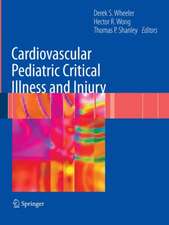A Guide to Neonatal and Pediatric ECGs
Autor Maria Albina Galli, Gian Battista Danzien Limba Engleză Paperback – 23 aug 2016
| Toate formatele și edițiile | Preț | Express |
|---|---|---|
| Paperback (1) | 583.08 lei 38-44 zile | |
| Springer – 23 aug 2016 | 583.08 lei 38-44 zile | |
| Hardback (1) | 655.34 lei 38-44 zile | |
| Springer – 31 ian 2013 | 655.34 lei 38-44 zile |
Preț: 583.08 lei
Preț vechi: 613.77 lei
-5% Nou
Puncte Express: 875
Preț estimativ în valută:
111.59€ • 116.07$ • 92.12£
111.59€ • 116.07$ • 92.12£
Carte tipărită la comandă
Livrare economică 11-17 aprilie
Preluare comenzi: 021 569.72.76
Specificații
ISBN-13: 9788847039193
ISBN-10: 8847039193
Pagini: 173
Ilustrații: IX, 173 p. 103 illus., 6 illus. in color.
Dimensiuni: 193 x 260 mm
Ediția:Softcover reprint of the original 1st ed. 2013
Editura: Springer
Colecția Springer
Locul publicării:Milano, Italy
ISBN-10: 8847039193
Pagini: 173
Ilustrații: IX, 173 p. 103 illus., 6 illus. in color.
Dimensiuni: 193 x 260 mm
Ediția:Softcover reprint of the original 1st ed. 2013
Editura: Springer
Colecția Springer
Locul publicării:Milano, Italy
Cuprins
Part I: Normal ECG.- Methodology for reading.-Newborn model.- Infant model.- Adult model.-Parameters of a normal pediatric ECG.- Part II: Pathological patterns.-Right ventricular overload.- Right systolic ventricular overload.- Right diastolic ventricular overload.- Left ventricular overload.- Left systolic and diastolic ventricular overload.- Biventricular overload.- Miscellaneous – ECG.- Pediatric ECG indications.- Bibliography.
Recenzii
From the reviews:
“The purpose is to educate providers taking care of neonatal and pediatric patients about both normal and abnormal features of ECG with correlation to the patient’s volume status. This book is most suitable for students, physicians in training, midlevel practitioners, and clinicians who interpret electrocardiograms of these patients. … This is an interesting book because of the correlation of ECG changes associated with hemodynamic parameters in the neonatal and pediatric population with comparison to, and examples of, both normal and abnormal findings.” (Saima Karim, Doody’s Book Reviews, July, 2013)
“The purpose is to educate providers taking care of neonatal and pediatric patients about both normal and abnormal features of ECG with correlation to the patient’s volume status. This book is most suitable for students, physicians in training, midlevel practitioners, and clinicians who interpret electrocardiograms of these patients. … This is an interesting book because of the correlation of ECG changes associated with hemodynamic parameters in the neonatal and pediatric population with comparison to, and examples of, both normal and abnormal findings.” (Saima Karim, Doody’s Book Reviews, July, 2013)
Notă biografică
Maria Albina Galli is a pediatric cardiologist who works at the Fondazione IRCCS Ca’ Granda-Ospedale Maggiore Policlinico, Milan, Italy. Dr. Galli gained a degree in medicine and surgery from the University of Milan before obtaining a specialist degree in cardiology from the University of Pavia. She has worked extensively in cardiology and in pediatric/fetal cardiology in particular. The main current foci of her work include the diagnosis and treatment of pediatric patients with congenital or acquired heart diseases and prenatal diagnosis by means of fetal echocardiography.
Textul de pe ultima copertă
Electrocardiography has an ever-expanding role in pediatric cardiology evaluation. The specific competencies required for its optimal use in this setting, however, generally lie beyond the expertise of cardiologists used to dealing with adults. This guide – the product of extensive practical experience in the field of pediatric cardiology – proposes a very simple method for reading neonatal and pediatric ECGs that is based on the application of straightforward criteria and permits the immediate recognition of normal and pathological patterns. The first part of the guide presents and describes this methodology and the parameters of normal pediatric ECGs, while the second part focuses on specific pediatric anomalies. More than 150 ECGs displaying both normal and pathologic findings are included, all of which have been collected from clinical practice and analyzed using the proposed method. This book will be an invaluable reference tool for all cardiologists who deal with newborns and children.
Caracteristici
Easy-to-use reference tool for cardiologists Highly relevant to daily practice Proposes a straightforward method for reading neonatal and pediatric ECGs Includes more than 150 ECGs evaluated according to the proposed method






